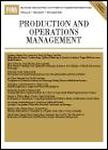版权所有:内蒙古大学图书馆 技术提供:维普资讯• 智图
内蒙古自治区呼和浩特市赛罕区大学西街235号 邮编: 010021

作者机构:Univ Penn Sch Engn & Appl Sci Philadelphia PA USA Texas A&M Univ Mays Business Sch Dept Informat & Operat Management College Stn TX USA Texas A&M Univ Mays Business Sch Dept Informat & Operat Management 4217 TAMU College Stn TX 77843 USA
出 版 物:《PRODUCTION AND OPERATIONS MANAGEMENT》 (生产与运营管理)
年 卷 期:2023年第32卷第3期
页 面:740-761页
核心收录:
学科分类:12[管理学] 120202[管理学-企业管理(含:财务管理、市场营销、人力资源管理)] 0202[经济学-应用经济学] 02[经济学] 1202[管理学-工商管理] 1201[管理学-管理科学与工程(可授管理学、工学学位)] 0802[工学-机械工程]
主 题:chain matching dual-donor organ exchange exchange cycles mathematical programming maximum independent set nonprofit operations NP-complete
摘 要:We study an optimal matching problem in the context of dual-donor organ exchange, where a portion of two living donors organs are transplanted to a single patient. This dual-donor transplant technique is becoming more widespread for lung and liver transplants. However, multiple medical compatibility criteria pose a serious challenge for matching a patient with two compatible donors. In the United States and many other countries, laws prohibit commercial (for-profit) deals for human organs, so donor exchanges are run by nonprofit organizations connecting donors with people in need of organs, with the goal of increasing transplant matches. We propose a simple chain mechanism in dual-donor organ exchange to increase the number of patient-dual-donor matches, which would maximize the number of patients receiving transplants. Based on this objective, we propose a general simple chain optimization framework for finding the maximum patient matching, taking into account multiple compatibility criteria (e.g., blood type and weight), and determine the complexity status of the problem. We provide theoretical results on the structures of simple chains, as well as a polynomial time algorithm to obtain the maximum patient matching simple chain with blood type compatibility. Through a numerical study for multiple compatibility criteria, we show that in many scenarios, a simple chain substantially increases the number of patients matched with dual donors for transplants, as opposed to exchange cycles. We also address the problem of maximizing the number of patients matched for dual-donor organ transplants via two-way and three-way exchange cycles, subject to donors and recipients medical compatibility criteria, along with a discussion of their computational complexity. Finally, we characterize the general configurations of large n-way exchange cycles and provide theoretical insights for their structural properties. Our findings provide general optimization models for dual-donor o